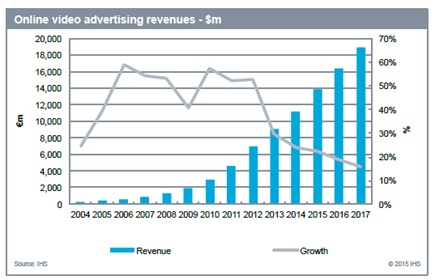YouTube and Facebook video ads are eating into TV commercial revues across the world, with global advertising revenue from online video doubled to $11.2 billion between 2011 and 2014, according to new research.
The study, from IHS and Vidiro, also indicate that and video ad revenues will jump to $13.8bn in 2015.
“Online video advertising is exploding,” said Eleni Marouli, senior analyst, IHS Technology.
“Video has become a fixture in media plans as advertisers are familiar and happy with its format.”
Advertising is the principal mechanism of monetizing online video, generating more revenues than subscription or transactions, according to the IHS and Vidiro white paper.
IHS forecasts that by 2017, online video advertising revenues will reach $19 billion, with TV advertising budgets beginning to see cannibalization by digital in some markets. TV will make up only 28 percent of total advertising in Western Europe at that time.
The changing structure of online video: re-defining television
TV is taking a hit from online and on-demand video. In 2013, TV (also known as linear viewing) declined by seven minutes per person. In contrast, online video services have seen impressive growth and increasing viewing share in the past two years, with
YouTube’s numbers showing a 50 percent growth in hours watched, year on year.
The structure of the online video market is changing rapidly as well. As online content consumption grows, content production is also increasingly moving online. Technology companies, who traditionally focused on improving ad formats to increase their revenues, are now investing heavily in content to compete for TV ad budgets.
“YouTube leads the pack by combining a content strategy with an aggressive advertising strategy,” said Anna Stuart, senior analyst at IHS Technology. “YouTube advertising revenue in 2014 amounted to $4.2 billion, up in double digits from 2013.”
Programmatic buying and selling is rapidly taking hold of video, the white paper says. Paired with data and measurement standards, programmatic advertising is improving effectiveness and efficiency of the transactional process, as well as measurement, attribution and optimization.
Facebook is significant threat to online video publishers
In 2014, Facebook surpassed YouTube as the leader in online video impressions. “Despite its late start into video, Facebook will be a significant threat to online video publishers for ad revenue,” Marouli said. “We forecast that it will account for 25.7 percent of all online video ad revenue by 2018.”
Facebook has one of the strongest video strategies both in terms of content and monetization, according to the IHS white paper. It is working closely with premium publishers to distribute content and is expanding its video ad solutions to provide strong format and targeting capabilities.
A new approach to measure Multichannel Networks (MCNs)
Since online video is here to stay, understanding how it performs is crucial. VIDIRO curates YouTube inventory to collect detailed information on the top 1.5 million performing channels, including the MCN affiliation for each.
The database stores all data relating to views, subscribers and audience engagement for these 1.5 million channels containing 122 million videos and is updated daily and hourly for the top performing segments, providing a MCN ‘fingerprint’. Using the wealth of data available from YouTube, the Vidiro MCN ‘fingerprint’ offers a more comprehensive and comparable way to measure the audience share of an MCN across the whole YouTube universe. It offers a quick way to evaluate MCN performance, scale and structure to competitors and peers.
“Stylehaul’s share of views in the top 10,000 YouTube channels is 10 percent’s of Vevo’s,” said Simon Factor, CEO of Vidiro. “But they compete strongly with Vevo across the long tail in terms of subscriber growth, picking up one subscriber for every two Vevo gains.”
Such a statistic demonstrates a high level of engagement amongst Stylehaul fans, but it also points towards differences in how fans consume beauty versus music videos. Due to the music playlisting feature on YouTube, users rely on auto-play and are less inclined to click and subscribe on individual music channels.
